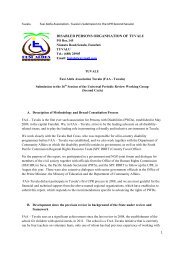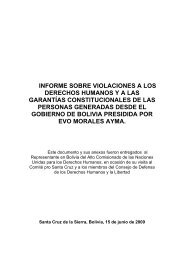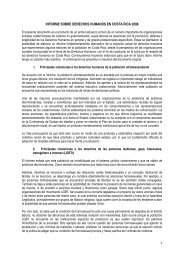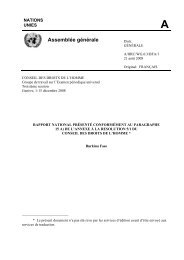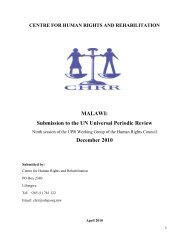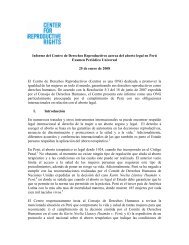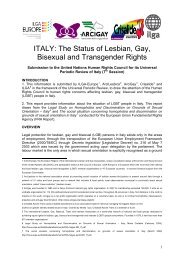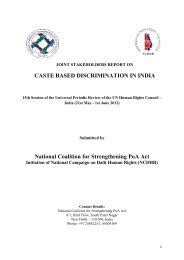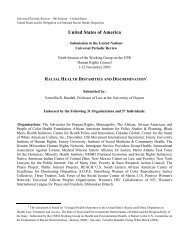Prison Needle Exchange: Lessons from a Comprehensive Review ...
Prison Needle Exchange: Lessons from a Comprehensive Review ...
Prison Needle Exchange: Lessons from a Comprehensive Review ...
Create successful ePaper yourself
Turn your PDF publications into a flip-book with our unique Google optimized e-Paper software.
contained and standards presented in these instruments, it can be argued that Canadian prisons<br />
(both federal and provincial/territorial) have a legal obligation to provide prisoners with<br />
access to sterile needles. Further, it can be argued that prisoners who have suffered damage<br />
or harm as a result of the failure on the part of prison authorities to provide access to sterile<br />
needles might have a successful legal cause of action against such authorities. Such an action<br />
could be based on the Charter and the common law (for example, an action in negligence).<br />
Inadequacy of bleach<br />
In Canada, bleach is available as a harm-reduction measure in many prisons. 264 Bleach is an<br />
important harm-reduction option for injection-drug-using prisoners who do not have access<br />
to sterile needles. However, it is not a substitute for sterile needles among people who risk<br />
HIV and HCV infection as a result of injection drug use.<br />
The efficacy of using bleach to eliminate HIV in syringes has been well established, 265 but<br />
bleach is not fully effective in reducing HCV transmission. 266 As well, previous studies indicate<br />
that many injection drug users have trouble remembering how to properly disinfect<br />
syringes using bleach. 267 In numerous studies, half or more of injection drug users do not<br />
know or do not practise the proper method of using bleach for disinfecting needles. 268<br />
Therefore, bleach is not regarded as the gold standard for preventing the transmission of<br />
infectious diseases among injection drug users. Further, and specific to harm-reduction measures<br />
in the prison environment, evidence <strong>from</strong> Australia indicates that a substantial proportion<br />
of prisoners do not avail themselves of bleach even when it is made available. 269 The<br />
probability of effective decontamination of needles using bleach is further decreased in<br />
prison because cleaning is a time-consuming procedure and some prisoners may be reticent<br />
to engage in any activity that increases the risk that prison staff will be alerted to their illicit<br />
drug use.<br />
While providing bleach to prisoners is a positive measure, problems with program uptake,<br />
as well as the limited effectiveness of bleach in preventing HCV transmission, suggest that<br />
this intervention alone is clearly an inadequate response to drug-related harm in prisons. It<br />
has even been suggested that the reuse of an HIV-contaminated syringe cleaned with bleach<br />
may actually increase the risk of HIV transmission. 270 Many studies promoting the value of<br />
bleach as a harm-reduction measure still conclude that access to sterile syringes is preferable<br />
to disinfecting previously used needles. 271<br />
The experience of the needle exchange programs studied for this report indicates a number<br />
of other health benefits associated with needle exchange for prisoners, benefits that cannot<br />
be realized with bleach. These benefits include a significant reduction in abscesses and<br />
other vein problems that result <strong>from</strong> reusing dull or damaged needles, and a significant<br />
decrease in fatal and non-fatal overdoses in some institutions.<br />
<strong>Needle</strong> exchange programs have also improved staff safety by reducing or eliminating the<br />
risk to prison staff of accidental needle-stick injuries <strong>from</strong> concealed syringes during cell and<br />
personal searches. The provision of bleach does not offer this benefit to prison staff, as needles<br />
are still considered contraband within the institutions and are therefore hidden rather<br />
than stored safely in visible areas.<br />
That bleach is a suboptimal public health measure is true not only in the Canadian context,<br />
but also in all prison systems throughout the world that provide bleach or other disinfectants,<br />
but not access to sterile needles. According to UNAIDS, the provision of fullstrength<br />
bleach to prisoners as a harm-reduction measure has been adopted in prisons in<br />
Europe, Australia, Africa, and Central America. 272 Elected and prison officials in jurisdictions<br />
where prisoners have been provided with bleach in the absence of sterile needle distribution<br />
<strong>Needle</strong> <strong>Exchange</strong> Programs Should Be Implemented in <strong>Prison</strong>s in Canada 61



